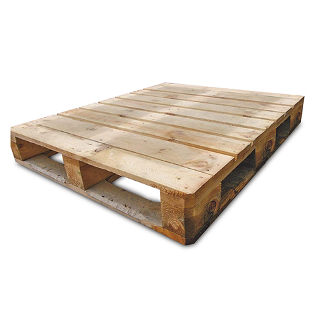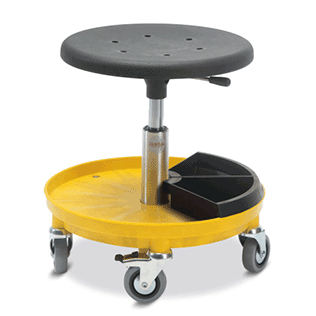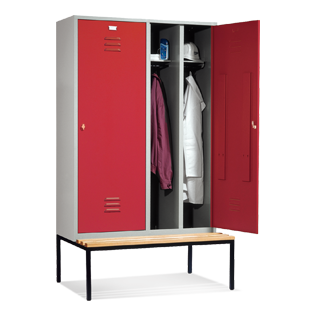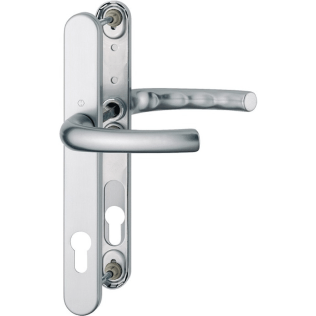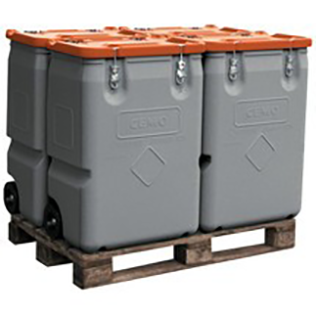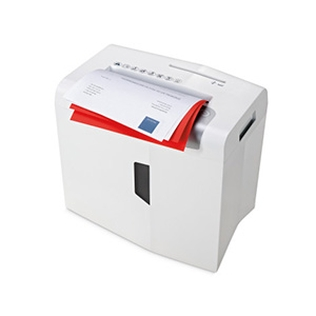Impact protectors: increased safety for employees and facilities
Impact protectors guarantee the necessary safety of your employees and provide certain protection for your operational equipment in case of collision. You can find suitable impact protection elements that match your requirements with the help of our guide.
1. Types of impact protectors
Whether indoors or outdoors, for traffic routes or in the warehouse – impact protection elements can be used in many different ways. Accordingly, these elements differ in terms of their size, material, shape and other features. You can choose from a wide range of products in the Jungheinrich PROFISHOP online store:







2. Why are impact protectors essential for a company?
Impact protectors are crucial for ensuring operational safety in the workplace. While there are currently no compulsory regulations on the establishment of collision and impact elements in the UK, standard BS 6180 outlines a series of recommendations and guidelines on this subject. All warehouse impact protection products available in our shop are tested in their respective areas of application and offer the following benefits when it comes to operational safety:
- As a means of accident prevention: The appropriate product can be used to separate work areas or clearly mark obstacles and other potential hazards. Protection elements can also indicate safe routes for employees or customers, thereby preventing accidents from occurring in the first place.
- As a form of impact and collision protection: Collision protectors are designed to absorb the impact of collisions, such as those that may occur when an industrial truck collides with a storage rack. They minimise the risk of damage to factory equipment and prevent shelves from toppling over. Depending on the specific application of the protective element, pipes, pillars or walls can also be protected in the event of a collision.
- Cost savings: Collisions resulting in damage to vehicles and storage facilities can lead to expensive repairs and downtime. Although investments in high-quality impact protectors may initially incur costs, the expenses can be quickly recouped by avoiding accidents and consequential damage. This can be particularly beneficial for companies that use high-quality machines, transport or lifting trucks.
3. Finding the right impact protection elements
Code of practice standard BS 6180 outlines which type of protective element is best suited to a particular working environment. Additionally, there are other parameters that can be considered when selecting the right impact protector for your specific requirements.
Material
We offer collision protection products made of steel, with or without coatings, as well as various plastics and polyurethane foam. All construction materials are suitable for indoor use. Most plastic models meet the highest impact protection requirements for outdoor use, however, with steel elements it is important to consider hot-dip galvanising or additional corrosion protection as an option when using outdoors:
| Material/Area | Indoor area | Outdoor area |
|---|---|---|
| Polyethylene | × | × |
| Polypropylene and HDPE | × | × |
| PU foam | × | × |
| Metal with plastic coating | × | × |
| Powder-coated steel | × | × |
| Hot-dip galvanised steel | × | × |
Impact protectors with a fluorescent coating are particularly suited to outdoor use, as they guarantee best possible visibility, even at night.
Function
Before purchasing impact protectors, it is essential to accurately determine their intended use. Should storage equipment be protected, and if so, which items? Will the protective elements serve as a barrier or marker? Is cushioning impact protection required? The following table provides an overview of the options available for different requirements:
| Function | Suitable impact protection |
|---|---|
Separation of different operating areas 
|
|
Marking and securing of traffic routes 
|
|
Impact protectors against collisions with industrial trucks and other vehicles 
|
|
Securing hazardous zones 
|
|
Securing of shelves 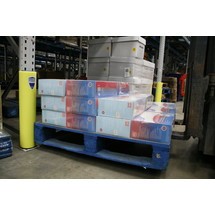
|
|
Securing columns, posts or pipes 
|
|
Fall protection 
|
|
4. Warehouse impact protection for hazardous areas
Jungheinrich PROFISHOP offers protective elements that are required to be installed either at a distance from the danger zone or directly in front of the objects that need to be protected. When installed at a distance, collision protection primarily prevents people from approaching the area. Additionally, impact protectors can also serve as an efficient traffic control system and aid in access control on company premises. We provide a variety of products for this purpose.
Impact protection barriers

Impact protection barriers are highly versatile and can be used to protect individuals, buildings, machines and technical systems, depending on their shape, dimensions and material. They can also be utilised as fall protection for stairways or ledges. We offer a wide range of impact protection barriers in various forms to meet your needs:
- round arch or inverted U-shape
- with cross braces
- as a 2-part round arch construction
- as a ground barrier
- with an angled profile
- with underrun protection
The brackets are constructed of strong tubular steel and can be conveniently bolted to the floor utilising base plates. For operational areas that require a high level of impact protectors, such as those with vehicles travelling at high speeds, the impact protection bar can be cemented into the ground. Our impact protector brackets are available in various diameters and wall thicknesses, allowing for optimal adaptation to your company's specific requirements.
Characteristics of impact protection barriers:
| Parameter | Details |
|---|---|
| Protective impact |
|
| Material |
|
| Area of application |
|
Impact protection rails
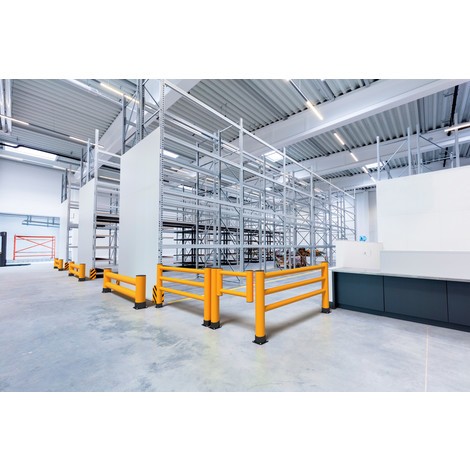
Warehouse impact protection rails are used to separate or mark paths in different operating areas. They are therefore ideal for outlining pedestrian areas or securing hazardous zones. Unlike impact protection barriers, railings offer a continuous barrier and, unless there is an intentional gap, neither vehicles nor people can enter the areas they surround.
Warehouse rails can be securely fixed into the ground using base plates to provide better resistance to approaching vehicles. Depending on the operating area, cushioning elements may also be used: railing posts with an inclined angle give way and divert the force of collision as gently as possible, reducing overall damage to vehicles. Some impact protection rails have a fluorescent coating to ensure they are visible even in low light conditions.
Characteristics of impact protection rails:
| Parameter | Details |
|---|---|
| Protective impact |
|
| Material |
|
| Area of application |
|
Impact protection boards

If you need to protect larger operating areas from potential damage caused by larger industrial machinery, but still need access to walls, stored goods, or work equipment, impact protection boards are an ideal choice. These boards, which are only around 30-40cm high, provide effective warehouse impact protection against stacker trucks or pallet jacks by absorbing the impact of vehicles at a lower height. These types of collision prevention elements are usually anchored directly into the ground. This is achieved with the use of robust support posts, which provide optimal force absorption. Impact protection boards also offer maximum safety when positioned in areas frequented by heavy or fast-moving vehicles. Extension sets can be used to adjust the boards to the conditions on site, allowing them to even be set up around corners.
Please note that impact protection boards do not provide underride protection. For this purpose, suitable impact protection barriers with underride protection should be used.
Characteristics of impact protection boards:
| Parameter | Details |
|---|---|
| Protective impact |
|
| Material |
|
| Area of application |
|
Impact protection bollard

Impact protection bollards are primarily used to secure traffic routes. They offer reliable protection for people, buildings and machines, especially when stacker trucks, pallet trucks and other vehicles are present on company premises. Impact protectors, such as these bollards, can even call attention to inconspicuous curves or building corners that may otherwise be easily missed. Depending on the intended use, bollards can be anchored or secured with concrete into the ground. HDPE bollards with tilting and auto-recovery features provide a gentler cushioning effect during collisions, thereby reducing the damage caused to vehicles.
Characteristics of impact protection bollards:
| Parameter | Details |
|---|---|
| Protective impact |
|
| Material |
|
| Area of application |
|
5. Impact protection designed to be mounted directly onto objects
Some of our impact protection elements can be installed directly onto objects such as shelves, pillars or edges, with the aim of preventing accidents from the onset and providing impact protection in case of collision. They primarily function as marking or warning systems that draw attention to hazards such as sharp edges, protrusions, landings or shelves.
Column protectors
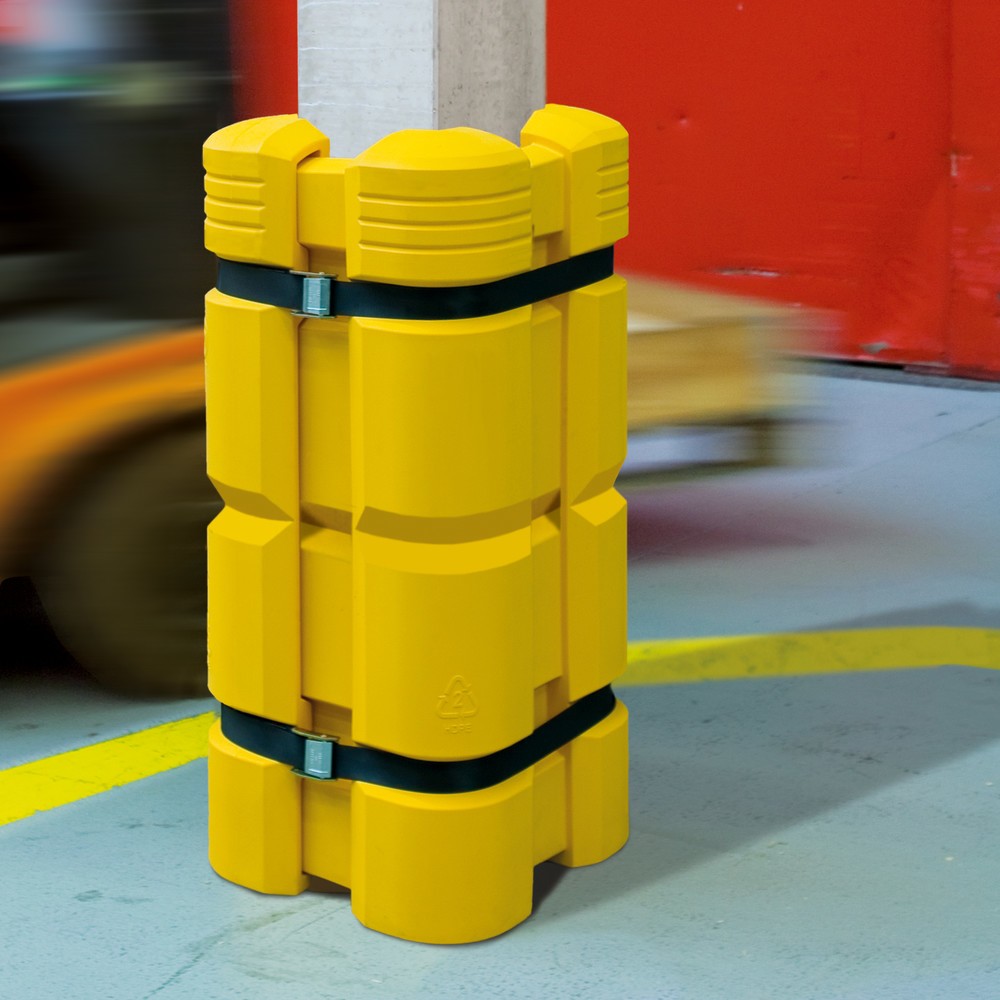
Our impact protection products can be installed at a safe distance from a hazardous area, with the extra space only adding to the performance of the impact protector used. Some of our products, however, provide optimal collision protection when mounted on the hazardous object itself. Ourcolumn protectors are one such example. They are specially designed to be mounted onto columns to prevent collisions. They are made of weather-resistant polyethylene and have internal cavities supported by plastic slats for dimensional stability.
Column protectors are not only highly stable and resistant to stress cracking, but their flexible integrated slats enable them to spring back in the event of an impact. This helps absorb impact energy, minimising and, in some cases, even preventing damage to vehicles. Available in signal colours, column impact protectors can be purchased from Jungheinrich PROFISHOP in a range of models that can be stretched around bollards or pillars.
Characteristics of column protectors:
| Parameter | Details |
|---|---|
| Protective impact |
|
| Material |
|
| Area of application |
|
Corner protection
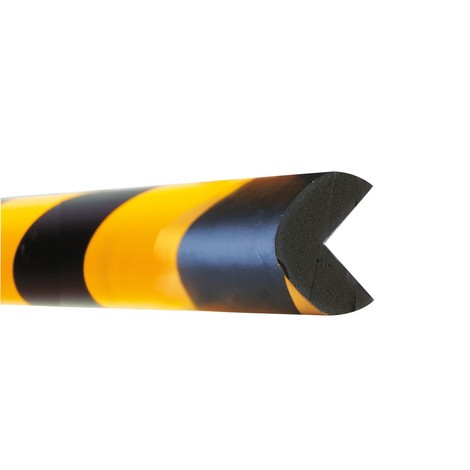
Our corner protection products provide reliable cushioning for corners and edges, such as those found on railings, passages, or pipes. Made from durable and solvent-resistant polyurethane foam (PU foam), our corner and edge protectors can be attached using self-adhesive or magnetic coatings. To ensure an optimal fit on the edges that need to be padded, our shop offers corner protection in various profiles:
- semicircle
- circle
- rectangle
- trapeze
- angled
Characteristics of corner protectors:
| Parameter | Details |
|---|---|
| Protective impact |
|
| Material |
|
| Area of application |
|
Rack protection
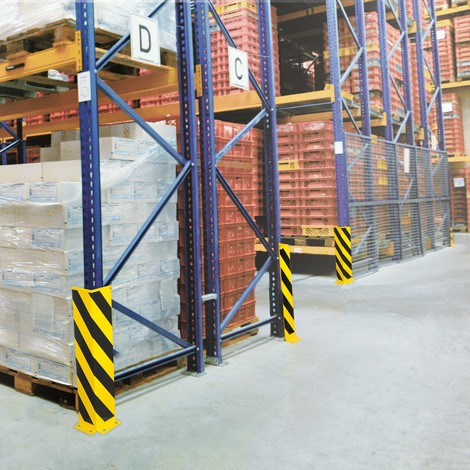
It is important that shelves, particularly heavy-duty shelves, are correctly secured in position to prevent injury or product damage at the workplace. At Jungheinrich PROFISHOP, you can purchase rack impact protection that can provide collision protection for racks and shelving systems of all sizes. All our impact protection elements for shelves have a minimum height of 30cm, feature conspicuous yellow or black and yellow colouring, and can withstand collision forces from 400 Nm. Depending on the design, our shelf and rack impact protectors can be attached to the shelf legs (shelf leg protection), front side or shelf ends. Our impact protection elements are primarily intended to prevent shelves from being damaged or collapsing as a result of collisions with vehicles.
Impact protection corners are crucial for protecting shelves from collisions. They are not only useful for storage racks, but also for safeguarding columns, steel beams, pipes or building corners. Collision elements for corners are used not only in warehouses but also in driveways or multi-storey car parks. They are fixed to the ground using concrete screws and are available in various profiles.
Characteristics of rack protectors:
| Parameter | Details |
|---|---|
| Protective impact |
|
| Profiles |
|
| Material |
|
| Area of application |
|
6. FAQ on impact protection
Proper installation is a crucial prerequisite in order for impact protection to serve its purpose. For many impact protection products, the accessories necessary for attachment are already included. For models that are fixed to walls or the floor, it is essential that the ground is stable enough to anchor the product securely; otherwise, it may tip over upon impact. Impact protection bollards, in particular, can be anchored into concrete for increased stability. You can also find instructions for professional assembly in the assembly and operating manual that comes with each impact protection product.
Impact protection products are sometimes equipped with an underrun protection. A protective wall that nearly touches the floor is placed between the sides of the bracket. This wall prevents stacker trucks from getting stuck in the impact protector as the machine’s fork cannot accidentally slide underneath it.
The choice of material for impact protection products depends on three main factors:
- The most critical factor is the level of performance that the collision protection needs to provide. Generally, the thicker the material and diameter, the more resistant the impact protection.
- Steel or plastic have different advantages and disadvantages when it comes to using impact protection in outdoor areas. Only plastic or hot-dip galvanised steel collision protection products can offer reliable protection against rust damage caused by moisture. Steel can cause damage to the protective zinc layer after collisions with vehicles, however it is preferable to plastic products for permanent UV resistance. Plastic impact protection is less durable when exposed to constant sunlight.
- Although steel elements are typically better at absorbing forceful impact, plastic impact protection products provide better protection for the approaching vehicle.






